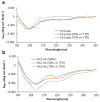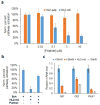Design and Evolution of a Macrocyclic Peptide Inhibitor of the Sonic Hedgehog/Patched Interaction
- PMID: 28759213
- PMCID: PMC5753398
- DOI: 10.1021/jacs.7b06087
Design and Evolution of a Macrocyclic Peptide Inhibitor of the Sonic Hedgehog/Patched Interaction
Abstract
The hedgehog (Hh) signaling pathway plays a central role during embryonic development, and its aberrant activation has been implicated in the development and progression of several human cancers. Major efforts toward the identification of chemical modulators of the hedgehog pathway have yielded several antagonists of the GPCR-like smoothened receptor. In contrast, potent inhibitors of the sonic hedgehog/patched interaction, the most upstream event in ligand-induced activation of this signaling pathway, have been elusive. To address this gap, a genetically encoded cyclic peptide was designed based on the sonic hedgehog (Shh)-binding loop of hedgehog-interacting protein (HHIP) and subjected to multiple rounds of affinity maturation through the screening of macrocyclic peptide libraries produced in E. coli cells. Using this approach, an optimized macrocyclic peptide inhibitor (HL2-m5) was obtained that binds Shh with a KD of 170 nM, which corresponds to a 120-fold affinity improvement compared to the parent molecule. Importantly, HL2-m5 is able to effectively suppress Shh-mediated hedgehog signaling and Gli-controlled gene transcription in living cells (IC50 = 230 nM), providing the most potent inhibitor of the sonic hedgehog/patched interaction reported to date. This first-in-class macrocyclic peptide modulator of the hedgehog pathway is expected to provide a valuable probe for investigating and targeting ligand-dependent hedgehog pathway activation in cancer and other pathologies. This work also introduces a general strategy for the development of cyclopeptide inhibitors of protein-protein interactions.
Conflict of interest statement
The authors declare no competing financial interest.
Figures








Similar articles
-
Pseudo-active sites of protease domains: HGF/Met and Sonic hedgehog signaling in cancer.Biol Chem. 2010 Aug;391(8):881-92. doi: 10.1515/BC.2010.098. Biol Chem. 2010. PMID: 20536384 Review.
-
In vitro and in vivo inhibition of breast cancer cell growth by targeting the Hedgehog/GLI pathway with SMO (GDC-0449) or GLI (GANT-61) inhibitors.Oncotarget. 2016 Feb 23;7(8):9250-70. doi: 10.18632/oncotarget.7062. Oncotarget. 2016. PMID: 26843616 Free PMC article.
-
The structure of SHH in complex with HHIP reveals a recognition role for the Shh pseudo active site in signaling.Nat Struct Mol Biol. 2009 Jul;16(7):691-7. doi: 10.1038/nsmb.1632. Epub 2009 Jun 28. Nat Struct Mol Biol. 2009. PMID: 19561609
-
Sonic hedgehog signaling plays an essential role during embryonic salivary gland epithelial branching morphogenesis.Dev Dyn. 2004 Apr;229(4):722-32. doi: 10.1002/dvdy.10472. Dev Dyn. 2004. PMID: 15042696
-
Genomic testing, tumor microenvironment and targeted therapy of Hedgehog-related human cancers.Clin Sci (Lond). 2019 Apr 29;133(8):953-970. doi: 10.1042/CS20180845. Print 2019 Apr 30. Clin Sci (Lond). 2019. PMID: 31036756 Review.
Cited by
-
Expanded toolbox for directing the biosynthesis of macrocyclic peptides in bacterial cells.Chem Sci. 2020 May 27;11(24):6202-6208. doi: 10.1039/d0sc01699c. eCollection 2020 Jun 28. Chem Sci. 2020. PMID: 32953014 Free PMC article.
-
Designing high affinity target-binding peptides to HLA-E: a key membrane antigen of multiple myeloma.Aging (Albany NY). 2020 Oct 28;12(20):20457-20470. doi: 10.18632/aging.103858. Epub 2020 Oct 28. Aging (Albany NY). 2020. PMID: 33115963 Free PMC article.
-
Synthesis of 2-methoxybenzamide derivatives and evaluation of their hedgehog signaling pathway inhibition.RSC Adv. 2021 Jun 28;11(37):22820-22825. doi: 10.1039/d1ra00732g. eCollection 2021 Jun 25. RSC Adv. 2021. PMID: 35480433 Free PMC article.
-
Genetically Encoded Cyclic Peptide Phage Display Libraries.ACS Cent Sci. 2020 Mar 25;6(3):336-338. doi: 10.1021/acscentsci.0c00087. Epub 2020 Feb 24. ACS Cent Sci. 2020. PMID: 32232131 Free PMC article. No abstract available.
-
Computationally Designed Cyclic Peptides Derived from an Antibody Loop Increase Breadth of Binding for Influenza Variants.Structure. 2020 Oct 6;28(10):1114-1123.e4. doi: 10.1016/j.str.2020.04.005. Epub 2020 Jun 30. Structure. 2020. PMID: 32610044 Free PMC article.
References
-
- Denef N, Neubuser D, Perez L, Cohen SM. Cell. 2000;102:521. - PubMed
Publication types
MeSH terms
Substances
Grants and funding
LinkOut - more resources
Full Text Sources
Other Literature Sources
Miscellaneous

